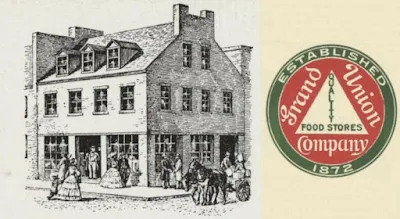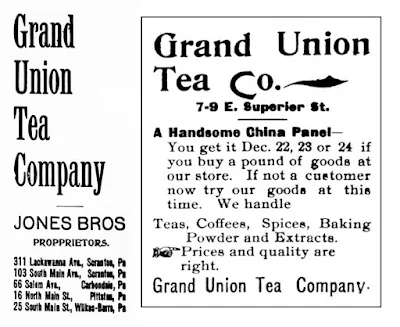Our ftfth Food Store Focus provides a history of the Grand Union Company. The first Grand Union Tea Company store opened, in Scranton, Pennsylvania, on September 1, 1872. Founded by Cyrus D. Jones, the name of the enterprise was (apparently) a homage to "The Grand Union," America's first flag, which was first displayed in 1775.
Drawing and graphic from The Grand Union "Information Regarding Your Company" brochure 1939
The first Grand Union stores were established in eastern Pennsylvania and Saginaw, Michigan. The advert above announces that an Auburn, New York unit will be relocating in March 1888. In 1890, there were fifty stores. By 1899, over 140 were in business in locales including Harrisburg and Shenandoah {Pennsylvania}, Wilmington {Delaware}, Kansas City {Missouri}, Council Bluffs {Iowa}, Omaha and Sacramento.
Advert from the Grand Union Tea Company
Cyrus Jones was joined in the business by brothers Charles and Frank in 1873. They established Jones & Brothers to oversee their various business interests and are mentioned as "proprietors" in the circa-1896 newspaper ad on the left. The advert on the right, from 1897, informs the public that -on December 22 to 24- customers will receive a free "handsome china panel" with the purchase of one pound of goods. Premiums, such as dishes and printed pictures, were a major customer incentive at the time.
Adverts from the Grand Union Tea Company
Early Grand Union units were not a grocery store-type of business, as this circa-1901 ad attests. Only coffees, teas, flavorings and spices were sold. By the turn of the 20th century, a massive warehouse and headquarters had been established on Jay Street, in Brooklyn. Merrill, Lynch & Company acquired all Jones & Brothers business interests -including Grand Union- and merged them into a new concern known as the Jones Brothers Tea Company. The deal was finalized on December 5, 1916.
Advert from the Grand Union Tea Company
In May 1928, the Jones Brothers enterprise was re-incorporated as the Grand Union Company. A new headquarters was established in Manhattan's Woolworth Building. At this time, the chain consisted of 120 direct-to-home service routes and 650 grocery stores, with 100 selling groceries, as well as meats and produce. These covered the states of Connecticut, Massachusetts, New York, Pennsylvania and Vermont.
Graphic from the Grand Union Company
During the 1920s and '30s, the chain expanded by building new stores and acquiring existing chains. These included John J. Tomich, Globe Grocery Stores, Japan Tea Company, Minnesota Tea Company, King Koffee Company and Glenwood Stores. Due to shutterings and consolidations, the store count in 1939 stood at 502 markets and 1,000 direct-to-home service routes.
Graphic from the Grand Union Company
The supermarket format was fully embraced during the 1940s. These stores were much larger than the standard grocery and included refrigerated produce stands, a self-service "meateria" and -often- a "food-o-mat" self-filling display. In 1945, Grand Union was overseeing 319 stores, with 163 including a meat department. A new corporate headquarters had just been established on Manhattan's Church Street.
Photo from The Grand Union "Information Regarding Your Company" brochure 1939
The door-to-door selling of non-perishable grocery items had been a Grand Union endeavor since the early days. By the mid-20th century, this was known as the direct-to-home service or route division. Salesmen would call on customers who would purchase from a selection of over 200 items. These included coffee, tea, cocoa, cakes, desserts, soap products, cosmetics and toiletries. This division had been shut down by the early 1960s.
Graphic from the Grand Union Company
In November 1951, Grand Union moved its Church Street Manhattan corporate headquarters to a shiny new shopping plaza in the Borough of East Paterson (now Elmwood Park), New Jersey. The office complex occupied floors 2 though 4 and the entirety of an 8-story tower. A futuristic Grand Union supermarket was on the ground floor.
Drawing from the Grand Union Company
This trademark was introduced in 1951. Grand Union had just acquired New Jersey-based Great Eastern Stores. In 1953, The Carroll's, Limited chain -of Ontario, Canada- was merged into Grand Union, as was Food Fair Super Markets -of Washington, DC- which was obtained in 1955. In 1956, a Florida division was established. The company was now operating 356 stores in Connecticut, Florida, Maryland, Massachusetts, New Jersey, New York, Pennsylvania, Vermont, Virginia, the District of Columbia and Canada.
Graphic from the Grand Union Company
This trademark debuted in 1964, when Grand Union was operating 492 supermarkets in Connecticut, Florida, Maryland, Massachusetts, New Hampshire, New Jersey, New York, Pennsylvania, Vermont, Virginia, West Virginia and the District of Columbia. All Canadian stores had been sold in 1959, just as a new division in Puerto Rico was being established.
Graphic from the Grand Union Company
A '60s shopper peruses the array of produce available at Grand Union. In addition to food stuffs, all stores awarded Triple-S Blue Stamps with every purchase. In 1967, the company operated 531 supermarkets in eleven states, the District of Columbia and Puerto Rico.
Photo from the Grand Union Company Annual Report 1967
In 1975, there were 487 Grand Union stores in eleven states, the District of Columbia, Puerto Rico and the US Virgin Islands. The "Red Dot" logo first appeared in 1981. By this time, the chain had endured a hostile takeover. It was sold in 1988 and -again- in 1989. During the late '80s, the chain was profitable, but was soon in serious debt. Chapter 11 bankruptcies were filed in 1995, 1998 and 2000, with the latter reduced to a Chapter 7.
Graphic from the Grand Union Company
Meanwhile, the headquarters had moved from Elmwood Park to Wayne, New Jersey in 1987 and to Clifton Park, New York in 2001. Grand Union was sold to New England's C & S Wholesale Grocers. They downsized the chain, leaving only operational stores in Upstate New York and New England. Remaining units were rebranded under a new Grand Union Family Markets banner. These twenty-one stores were acquired by New York State's Tops Markets in July 2012, thus ending the once-mighty Grand Union enterprise.
Photo from Wikipedia / " Litefantastic"
Graphic from GU Markets, Limited Liability Company
GRAND UNION JUNIOR-ANCHORED SHOPPING MALLS:
*GARDEN STATE PLAZA, Paramus, NJ (1957)
*PRINCE GEORGE'S PLAZA, Hyattsville, MD (1959)
*NORTHSIDE CENTER, Dade County, FL (1960)




















